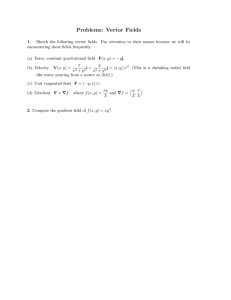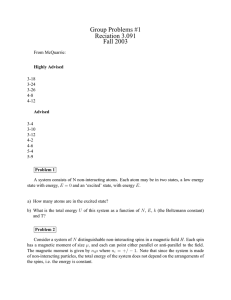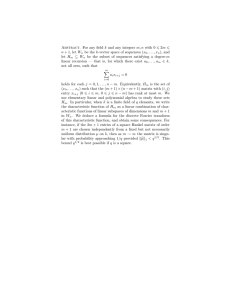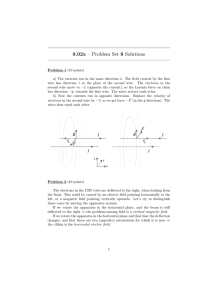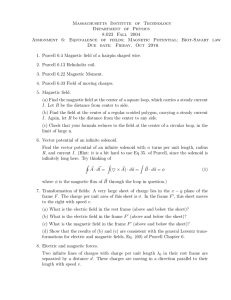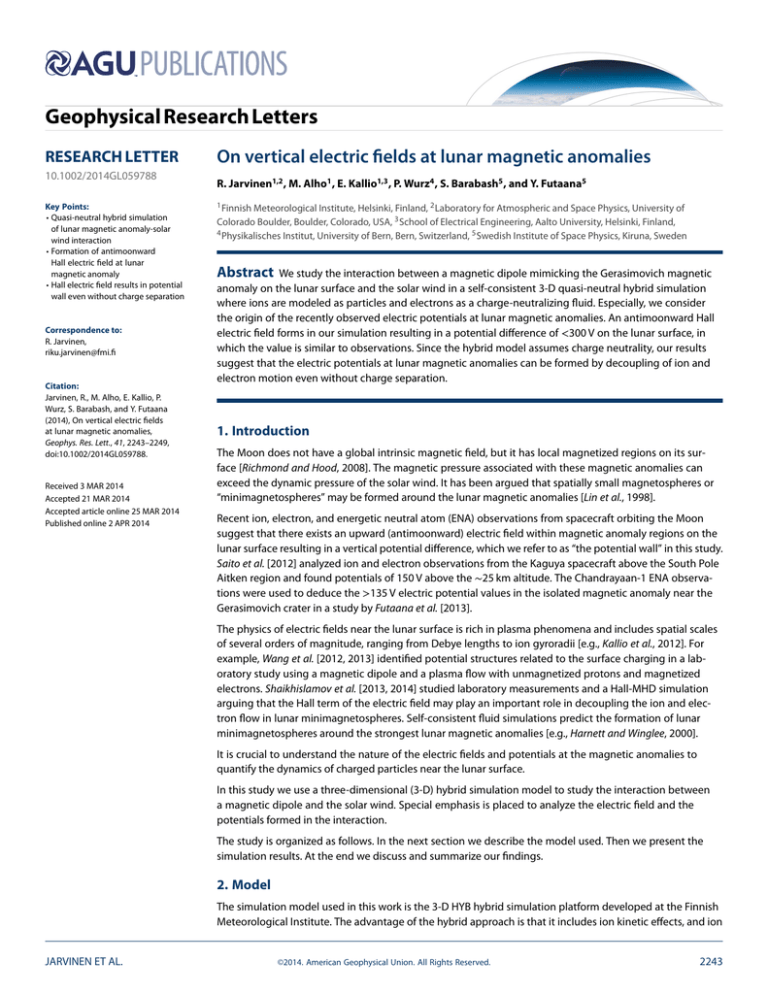
Geophysical Research Letters
RESEARCH LETTER
10.1002/2014GL059788
Key Points:
• Quasi-neutral hybrid simulation
of lunar magnetic anomaly-solar
wind interaction
• Formation of antimoonward
Hall electric field at lunar
magnetic anomaly
• Hall electric field results in potential
wall even without charge separation
Correspondence to:
R. Jarvinen,
riku.jarvinen@fmi.fi
Citation:
Jarvinen, R., M. Alho, E. Kallio, P.
Wurz, S. Barabash, and Y. Futaana
(2014), On vertical electric fields
at lunar magnetic anomalies,
Geophys. Res. Lett., 41, 2243–2249,
doi:10.1002/2014GL059788.
Received 3 MAR 2014
Accepted 21 MAR 2014
Accepted article online 25 MAR 2014
Published online 2 APR 2014
On vertical electric fields at lunar magnetic anomalies
R. Jarvinen1,2 , M. Alho1 , E. Kallio1,3 , P. Wurz4 , S. Barabash5 , and Y. Futaana5
1 Finnish Meteorological Institute, Helsinki, Finland, 2 Laboratory for Atmospheric and Space Physics, University of
Colorado Boulder, Boulder, Colorado, USA, 3 School of Electrical Engineering, Aalto University, Helsinki, Finland,
4 Physikalisches Institut, University of Bern, Bern, Switzerland, 5 Swedish Institute of Space Physics, Kiruna, Sweden
Abstract
We study the interaction between a magnetic dipole mimicking the Gerasimovich magnetic
anomaly on the lunar surface and the solar wind in a self-consistent 3-D quasi-neutral hybrid simulation
where ions are modeled as particles and electrons as a charge-neutralizing fluid. Especially, we consider
the origin of the recently observed electric potentials at lunar magnetic anomalies. An antimoonward Hall
electric field forms in our simulation resulting in a potential difference of <300 V on the lunar surface, in
which the value is similar to observations. Since the hybrid model assumes charge neutrality, our results
suggest that the electric potentials at lunar magnetic anomalies can be formed by decoupling of ion and
electron motion even without charge separation.
1. Introduction
The Moon does not have a global intrinsic magnetic field, but it has local magnetized regions on its surface [Richmond and Hood, 2008]. The magnetic pressure associated with these magnetic anomalies can
exceed the dynamic pressure of the solar wind. It has been argued that spatially small magnetospheres or
“minimagnetospheres” may be formed around the lunar magnetic anomalies [Lin et al., 1998].
Recent ion, electron, and energetic neutral atom (ENA) observations from spacecraft orbiting the Moon
suggest that there exists an upward (antimoonward) electric field within magnetic anomaly regions on the
lunar surface resulting in a vertical potential difference, which we refer to as “the potential wall” in this study.
Saito et al. [2012] analyzed ion and electron observations from the Kaguya spacecraft above the South Pole
Aitken region and found potentials of 150 V above the ∼25 km altitude. The Chandrayaan-1 ENA observations were used to deduce the >135 V electric potential values in the isolated magnetic anomaly near the
Gerasimovich crater in a study by Futaana et al. [2013].
The physics of electric fields near the lunar surface is rich in plasma phenomena and includes spatial scales
of several orders of magnitude, ranging from Debye lengths to ion gyroradii [e.g., Kallio et al., 2012]. For
example, Wang et al. [2012, 2013] identified potential structures related to the surface charging in a laboratory study using a magnetic dipole and a plasma flow with unmagnetized protons and magnetized
electrons. Shaikhislamov et al. [2013, 2014] studied laboratory measurements and a Hall-MHD simulation
arguing that the Hall term of the electric field may play an important role in decoupling the ion and electron flow in lunar minimagnetospheres. Self-consistent fluid simulations predict the formation of lunar
minimagnetospheres around the strongest lunar magnetic anomalies [e.g., Harnett and Winglee, 2000].
It is crucial to understand the nature of the electric fields and potentials at the magnetic anomalies to
quantify the dynamics of charged particles near the lunar surface.
In this study we use a three-dimensional (3-D) hybrid simulation model to study the interaction between
a magnetic dipole and the solar wind. Special emphasis is placed to analyze the electric field and the
potentials formed in the interaction.
The study is organized as follows. In the next section we describe the model used. Then we present the
simulation results. At the end we discuss and summarize our findings.
2. Model
The simulation model used in this work is the 3-D HYB hybrid simulation platform developed at the Finnish
Meteorological Institute. The advantage of the hybrid approach is that it includes ion kinetic effects, and ion
JARVINEN ET AL.
©2014. American Geophysical Union. All Rights Reserved.
2243
Geophysical Research Letters
10.1002/2014GL059788
velocity distributions evolve according to the model calculation as ions are modeled as particles. The ion
dynamics are self-consistently coupled with the electric and magnetic field. Next we summarize the most
important features of the HYB-Anomaly model for this study (see details in Kallio et al. [2012]).
In the model the solar wind H+ ions are treated as particles moving under the Lorentz force:
⃗
mp d⃗vi ∕dt = e(E⃗ + v⃗i × B),
(1)
where mp is the proton mass, v⃗i is the ion velocity, e is the positive elementary charge, E⃗ is the electric field,
and B⃗ is the magnetic field. Electrons are modeled as a massless, charge-neutralizing fluid, and their velocity
is defined as
⃗ H+ − ⃗J∕(en) = U
⃗ H+ − ∇ × B∕(𝜇
⃗ 0 en),
⃗e = U
U
(2)
⃗ H+ is the ion bulk velocity; ⃗J is the electric current density defined by Amperè’s law; n is the electron
where U
number density, which according to the quasi-neutrality assumption of the model equals the proton number density; and 𝜇0 is the magnetic vacuum permeability. A notable feature in equation (2) is that the ion
and electron flows are not the same if electric currents exist even though the charge neutrality is assumed
in the model.
The magnetic field is propagated by Faraday’s law in a Cartesian simulation mesh of cubic grid cells. In
Faraday’s law a finite, constant resistivity term of the electric field was used to include some magnetic field
diffusion in the simulation.
The electric field is defined in the simulation as
⃗ ⃗
⃗ H+ × B⃗ + J × B .
⃗ e × B⃗ = − U
E⃗ = −U
en
⏟⏟⏟ ⏟⏟
⏟
E⃗conv
(3)
E⃗J×B
We call the first term the ion convection term (E⃗conv ) and the second term the Hall ⃗J × B⃗ term (E⃗J×B ).
Equation (3) is a simplified version of the full momentum equation, which includes, for example, the electron pressure term. However, the electron pressure of isothermal electrons was found to be not important
for the results of this study in our test runs. Further, note that equation (3) is derived assuming massless electrons, while the ion inertia is included in the model (equation (1)). Equation (3) states that the properties of
the magnetic field are associated (“frozen in”) with the electron motion. On the other hand, the ion motion
determines the “mass flow” in the model.
2.1. Coordinate System
The Cartesian coordinate system used in the model is defined as follows. The incident solar wind flow is
along the negative x axis, the anomaly dipole moment is along the z axis, and the y axis completes the
right-handed coordinate system. The origin is on the lunar surface directly above the dipole, and the
simulation box is horizontally centered around the origin.
2.2. Simulation Setup
A magnetic dipole mimicking the Gerasimovich anomaly is placed in the simulation at ⃗r = ( x = −50 km),
( y = 0, z = 0) under the surface with the surface magnitude of 96 nT along the x axis (23 nT at x = 30 km and
1 nT at x = 200 km) (the same as in our earlier study [Kallio et al., 2012]). The anomaly orientation is such that
the dipole field is directed along the negative z axis, which is opposite to the undisturbed interplanetary
magnetic field (IMF) in the origin. An incident solar wind speed of 300 km s−1 was chosen to correspond
to the case analyzed by Futaana et al. [2013]. The surface is treated as a particle-absorbing plane at x = 0.
Electric charging is not included in the hybrid model. The magnetic field is assumed to penetrate in the
surface undisturbed. That is, the Moon is assumed to be an ideal insulator. See Table 1 for a list of parameters
of the simulation run.
3. Simulation Results
Figure 1 illustrates the magnetic field and the proton flow in the simulation. Above x ∼100 km the magnetic field lines are the IMF field lines convecting toward the magnetic anomaly with the incident solar wind.
JARVINEN ET AL.
©2014. American Geophysical Union. All Rights Reserved.
2244
Geophysical Research Letters
10.1002/2014GL059788
Table 1. Details and Upstream Solar Wind (SW) Conditions of the
HYB-Anomaly Simulation Run Analyzed in This Work
Parameter
Box size (x × y × z) (km)
Number of grid cells (nx × ny × nz )
Grid cell size (Δx 3 )
Average macroparticles per cell
Time step (Δt)
Solution snapshot time
IMF B⃗ sw
SW E⃗sw
⃗ sw
SW H+ velocity U
SW H+ n and T
Value
(0...200) × (−200...200) × (−200...200)
30 × 60 × 60
(20∕3 km)3 ≈ (6.7 km)3
30
0.11 ms
6.2 s
[Bx , By , Bz ] = [0, 0, 6] nT
[Ex , Ey , Ez ] = [0, −1.8, 0] mV m−1
[Ux , Uy , Uz ] = [−300, 0, 0] km s−1
10 cm−3 , 76,000 K
Below x ∼100 km the magnetic field lines either connect to the IMF or the lunar surface. The “closed”
magnetic field lines connected to the surface at both ends are centered around the origin. The surface connection of the “open” field lines occurs at the z axis at around z = ±50 km in the polar region of the anomaly
dipole field (black contours in Figure 1). Also, a notable feature in Figure 1 is that the proton flow is vertical
almost everywhere.
Figure 2 analyzes the electric field and the electric current. At x ≤ 50 km a horizontal electric current system
(Jhor ) occurs where the current flows along the negative y axis in the middle (z = 0) and circles the polar
regions of the anomaly dipole field in the z < 0 and z > 0 hemispheres. Also, the magnitude of the electric
field at x < 30 km is higher near the origin than in the area surrounding the magnetic anomaly.
Figure 3 displays the electric field at x = 10 km separately for the full electric field, the Hall term, and the
ion convection term (equation (3)). Further, the electric field is shown separately for the total, vertical, and
horizontal components.
Two different regions can be identified in the total electric field (Figure 3a): The horizontal electric
√ field (the
solar wind convection electric field) dominates outside of the center of the anomaly √
region ( y2 + z2 ≳
2
2
50 km), and the vertical (Hall) electric field dominates in the central anomaly region
√ ( y + z ≲ 50 km).
2 + z 2 ≲ 50 km). At
In
Figures
3d–3f
it
can
be
seen
that
the
strongest
positive
vertical
fields
occur
at
(
y
√
y2 + z2 ≳ 50 km there is no visible vertical electric field (Figure 3d). Overall, the vertical component of
the electric field is a result of the Hall term, whereas the convection term does not contribute to the vertical
electric field (Figure 3e versus Figure 3f ).
Figure 1. Magnetic field and solar wind proton flow in the HYB-Anomaly hybrid simulation. The color map gives the
magnitude of the magnetic field on the surface. The black contours are the isocontours of Bx on the surface. The vertical
magenta lines are the bulk flow streamlines of the solar wind protons. Green lines are the magnetic field lines. The field
line tracing was started at altitudes below 150 km.
JARVINEN ET AL.
©2014. American Geophysical Union. All Rights Reserved.
2245
Geophysical Research Letters
10.1002/2014GL059788
Figure 2. Horizontal (yz) cuts of a lunar magnetic anomaly in the HYB-Anomaly hybrid simulation at x = 0...50 km altitudes. The color map shows the magnitude
of the electric field, and the curved gray arrows give the morphology of the horizontal component of the electric current density.
Figure 4 studies the altitude dependence of the electric potential. The potential is defined along the direction of the undisturbed solar wind flow (the x axis), and it is referred to as the anomaly potential (𝜙a ) in
this study:
𝜙a (⃗rp ) ≡
⃗rp
∫⃗rsw
⃗ r) ⋅ d⃗r + 𝜙(⃗rsw ),
E(⃗
(4)
where ⃗rsw is a point in the undisturbed solar wind at x = 200 km (the inflow boundary), ⃗rp is a point on the
⃗ sw (the x axis). The potential in the
shown yz plane in the figure, and the displacement vector d⃗r is along U
undisturbed solar wind is taken to be zero 𝜙(⃗rsw ) = constant = 0.
Equation (4) defines 𝜙a such that it is constant (set as zero here) along a flow line in the undisturbed
solar wind. Thus, changes in 𝜙a are associated with the electric field disturbances caused by the magnetic
⃗ sw , the change in 𝜙a is directly related to the change of the
anomaly. If a proton moves exactly along U
proton kinetic energy according to the conservation of energy in a stationary situation.
From Figure 4 it can be seen that
√ positive 𝜙a values start to occur at around the altitude of x = 20 km in the
central anomaly region within y2 + z2 ≲ 50 km. The anomaly potential reaches its maximum of around
300 V on the surface near the origin. Further, the anomaly potential increases with decreasing altitude indicating that the upward pointing electric field is a general feature within the anomaly and not constrained to
the x = 10 km surface as one might infer from Figure 3.
4. Discussion
We modeled the interaction between a lunar dipolar magnetic anomaly and the solar wind in a
self-consistent 3-D hybrid simulation. Especially, we analyzed the electric fields and the electric potential
created in the interaction.
In Figures 3d–3f it was seen that the Hall term dominates the antimoonward vertical electric field. What
causes this Hall field? According to equation (3) vertical Hall field arises when the ⃗J × B⃗ cross product is along
the x axis. This situation occurs since the magnetic field is mostly horizontal in the simulation except in the
dipole polar regions (Figure 1), and there exists a horizontal current (see Jhor in Figure 2).
JARVINEN ET AL.
©2014. American Geophysical Union. All Rights Reserved.
2246
Geophysical Research Letters
10.1002/2014GL059788
Figure 3. Properties of the electric field at x = 10 km in the HYB-Anomaly hybrid simulation. (left) The total electric field, (middle) the Hall electric field, and (right)
the ion convection electric field (equation (3)). (a–c) The full electric field vector, (d–f ) the vertical (x ) component, and (g–i) the horizontal (yz) component. The
color map gives the magnitude of the electric field term and component in question. The yellow arrows are the vectors of the electric field term and component in question. The arrow length is linearly proportional to the vector magnitude, but the maximum displayed vector arrow length is 6 mV m−1 to clarify the
illustration. All the color maps and vectors are at the same scale in the figure. The viewing angle in the plots is the same as in Figure 1.
Note that the horizontal component of the Hall field is also strong near the polar regions of the anomaly
(Figure 3h) where the magnetic field turns vertical (black contours in Figure 1). Vertical B⃗ and Jhor in these
regions result in the ⃗J × B⃗ cross product in the horizontal direction.
In the simulation the magnetic field is mostly horizontal because of the chosen IMF and dipole orientations, but why does Jhor that circles the dipole polar regions occur? To the first order the formation of this
current system can be understood as a result of an undisturbed solar wind proton flow across a magnetic
⃗ sw × B⃗ dipole expression (equation (3)), the undisturbed U
⃗ sw across
dipole field (B⃗ dipole ). According to the −U
⃗Bdipole gives rise to a “two-pole” pattern in the convection electric field (Econv ) circling the dipole poles in
z > 0 and z < 0 hemispheres similar to what is seen in Figures 3c and 3i. Econv is weak in the dipole polar
⃗ H+ are aligned (vertical) there, and Econv is the strongest near the x axis since B is
regions because B⃗ and U
the strongest there. Further, Econv in Faraday’s law results in the creation of a “two-pole” horizontal magnetic
field, which is associated with Jhor (Figure 2) via Amperè’s law.
The decoupling of ions and electrons allows the electrons to carry Jhor , whereas proton motion is mostly
vertical. If the Hall term is neglected in the electric field (equation (3)) and, thus, the electrons are forced to
flow with the ions, no Jhor occurs.
Why is there no formation of a “magnetopause” in the studied simulation case? In a fluid description the
pressure balance between the solar wind dynamic pressure and the dipole magnetic pressure along the
2
x axis reads as follows: mp nsw Usw
= B2 ∕(2𝜇0 ). The dynamic pressure of the undisturbed solar wind is
equal to the magnetic pressure of a ∼62 nT field in our simulation case. This magnitude of the dipole field
exists at the altitude of x ∼ 8 km, which we refer to as the “pressure balance altitude.” The gyroradius of
an H+ ion moving at 300 km s−1 perpendicular to the 62 nT field is 51 km, which is much larger than the
pressure balance altitude. Thus, the solar wind protons are not stopped at the pressure balance altitude
but impact in the surface due to their large gyroradii, and there is no formation of a “minimagnetosphere
magnetopause” boundary.
Since the ion flow is not stopped nor diverted much inside the magnetic anomaly field, there is no formation
of an ion cavity for the chosen plasma parameters. A study analyzing two fly-throughs of a strong magnetic
anomaly by Lunar Prospector showed that the formation of an ion cavity may be rare in lunar magnetic
anomalies [Halekas et al., 2008].
Even though the bulk flow of the solar wind protons is not stopped by the dipole field, small parts of protons
are deflected by the magnetic anomaly even in the present simulation case (see an example in Kallio et al.
JARVINEN ET AL.
©2014. American Geophysical Union. All Rights Reserved.
2247
Geophysical Research Letters
10.1002/2014GL059788
Figure 4. Horizontal (yz) cuts of the effective electric potential in the HYB-Anomaly hybrid simulation at x = 0...50 km altitudes. The color map gives the anomaly
potential 𝜙a defined in equation (4), and the isocontours give the magnitude of the magnetic field. Otherwise the figure is in the same format as Figure 2.
[2012, Figure 3b]). Further, the solar wind protons impacting the surface in the central anomaly region lose
energy when they move toward the antimoonward Hall field. Efficient ion deflection from lunar magnetic
anomalies was observed recently by Sub-keV Atom Reflecting Analyzer (SARA) on Chandrayaan-1 [Lue et al.,
2011], however, in a geometry with nonnormal incidence of the solar wind ions. Also, ENA data in studies
by Wieser et al. [2010] and Vorburger et al. [2012] show that a fraction of ions are deflected from the anomaly
for a nonnormal incidence geometry and that the anomalies slow down the solar wind protons resulting in
lower ENA energies than the incident solar wind proton energies.
There are several open questions about plasma physics of the lunar magnetic anomalies. First, near the surface, electron kinetics and surface charging play an important role in creating electric field within the Debye
sheath [see, e.g., Kallio et al., 2012; Wang et al., 2012, 2013]. Fully kinetic simulations, where both ions and
electrons are treated as particles, and plasma and surface charging are included, are called for to further
study the nature of the electric fields at the lunar magnetic anomalies within the Debye sheath. Second,
the simulation run studied here was carried out for a perpendicular solar wind with respect to the lunar
surface, which corresponds to the solar zenith angle of 0◦ . Most of the time the magnetic anomaly is not
in the subsolar point. In that case, the interaction becomes more complicated due to the smaller than 90◦
angle between the solar wind and the lunar surface. Further, the orientation of the magnetic anomaly in this
study was the same as in our earlier work [Kallio et al., 2012], but different orientations can result in different
kinds of solar wind interactions [Wang et al., 2013]. In our test runs the orientation of the IMF in the perpendicular direction to the undisturbed solar wind flow (the IMF clock angle) did not affect notably the results
concluded here.
5. Summary
We have studied the interaction between a magnetic dipole mimicking the Gerasimovich magnetic anomaly
on the lunar surface and the solar wind in a self-consistent 3-D quasi-neutral hybrid simulation where ions
are modeled as particles and electrons as a charge-neutralizing fluid. Especially, we considered the origin of
the recently observed electric potentials at lunar magnetic anomalies. An antimoonward Hall electric field
formed in our simulation resulting in a potential difference of <300 V on the lunar surface, in which the value
JARVINEN ET AL.
©2014. American Geophysical Union. All Rights Reserved.
2248
Geophysical Research Letters
10.1002/2014GL059788
is similar to recent observations [Saito et al., 2012; Futaana et al., 2013]. Since the hybrid model assumes
charge neutrality, our results suggest that the electric potentials at lunar magnetic anomalies can be formed
by decoupling of ion and electron motion even without charge separation.
Acknowledgments
The work of the lead author was supported by the Academy of Finland. All
figures were created using the VisIt
open source visualization tool.
The Editor thanks Mihaly Horanyi
and an anonymous reviewer for their
assistance in evaluating this paper.
JARVINEN ET AL.
References
Futaana, Y., S. Barabash, M. Wieser, C. Lue, P. Wurz, A. Vorburger, A. Bhardwaj, and K. Asamura (2013), Remote energetic neutral atom
imaging of electric potential over a lunar magnetic anomaly, Geophys. Res. Lett., 40, 262–266, doi:10.1002/grl.50135.
Halekas, J. S., G. T. Delory, D. A. Brain, R. P. Lin, and D. L. Mitchell (2008), Density cavity observed over a strong lunar crustal magnetic
anomaly in the solar wind: A mini-magnetosphere? Planet. Space Sci., 56, 941–946, doi:10.1016/j.pss.2008.01.008.
Harnett, E. M., and R. Winglee (2000), Two-dimensional MHD simulation of the solar wind interaction with magnetic field anomalies on
the surface of the Moon, J. Geophys. Res., 105, 24,997–25,008, doi:10.1029/2000JA000074.
Kallio, E., et al. (2012), Kinetic simulations of finite gyroradius effects in the lunar plasma environment on global, meso, and microscales,
Planet. Space Sci., 74, 146–155, doi:10.1016/j.pss.2012.09.012.
Lin, R. P., D. L. Mitchell, D. W. Curtis, K. A. Anderson, C. W. Carlson, J. McFadden, M. H. Acuna, L. L. Hood, and A. Binder (1998),
Lunar surface magnetic fields and their interaction with the solar wind: Results from Lunar Prospector, Science, 281, 1480–1484,
doi:10.1126/science.281.5382.1480.
Lue, C., Y. Futaana, S. Barabash, M. Wieser, M. Holmström, A. Bhardwaj, M. B. Dhanya, and P. Wurz (2011), Strong influence of lunar crustal
fields on the solar wind flow, Geophys. Res. Lett., 38, L03202, doi:10.1029/2010GL046215.
Richmond, N. C., and L. L. Hood (2008), A preliminary global map of the vector lunar crustal magnetic field based on Lunar Prospector
magnetometer data, J. Geophys. Res., 113, E02010, doi:10.1029/2007JE002933.
Saito, Y., M. N. Nishino, M. Fujimoto, T. Yamamoto, S. Yokota, H. Tsunakawa, H. Shibuya, M. Matsushima, H. Shimizu, and F. Takahashi
(2012), Simultaneous observation of the electron acceleration and ion deceleration over lunar magnetic anomalies, Earth Planets
Space, 64, 83–92, doi:10.5047/eps.2011.07.011.
Shaikhislamov, I. F., V. M. Antonov, Y. P. Zakharov, E. L. Boyarintsev, A. V. Melekhov, V. G. Posukh, and A. G. Ponomarenko
(2013), Mini-magnetosphere: Laboratory experiment, physical model and Hall MHD simulation, Adv. Space Res., 52, 422–436,
doi:10.1016/j.asr.2013.03.034.
Shaikhislamov, I. F., Y. P. Zakharov, V. G. Posukh, A. V. Melekhov, V. M. Antonov, E. L. Boyarintsev, and A. G. Ponomarenko (2014),
Experimental study of a mini-magnetosphere, Plasma Phys. Controlled Fusion, 56(2), 025004, doi:10.1088/0741-3335/56/2/025004.
Vorburger, A., P. Wurz, S. Barabash, M. Wieser, Y. Futaana, M. Holmström, A. Bhardwaj, and K. Asamura (2012), Energetic neutral atom
observations of magnetic anomalies on the lunar surface, J. Geophys. Res., 117, A07208, doi:10.1029/2012JA017553.
Wang, X., M. Horányi, and S. Robertson (2012), Characteristics of a plasma sheath in a magnetic dipole field: Implications to the solar
wind interaction with the lunar magnetic anomalies, J. Geophys. Res., 117, A06226, doi:10.1029/2012JA017635.
Wang, X., C. T. Howes, M. Horányi, and S. Robertson (2013), Electric potentials in magnetic dipole fields normal and oblique to a
surface in plasma: Understanding the solar wind interaction with lunar magnetic anomalies, Geophys. Res. Lett., 40, 1686–1690,
doi:10.1002/grl.50367.
Wieser, M., S. Barabash, Y. Futaana, M. Holmström, A. Bhardwaj, R. Sridharan, M. B. Dhanya, A. Schaufelberger, P. Wurz, and K. Asamura
(2010), First observation of a mini-magnetosphere above a lunar magnetic anomaly using energetic neutral atoms, Geophys. Res. Lett.,
37, L05103, doi:10.1029/2009GL041721.
©2014. American Geophysical Union. All Rights Reserved.
2249



